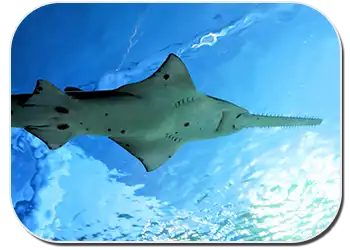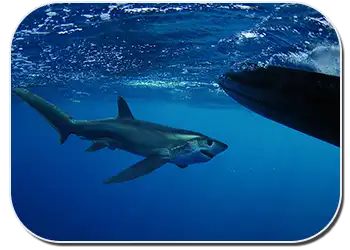There are almost 500 known species of sharks in our oceans. In this vast diversity of sharks, there is a huge variety of characteristics and behaviors among the different species. With all of these different species, it is hard to get enough information about sharks. So we’ve narrowed down the ten most unusual species of sharks, so you can learn just how diverse sharks species really are:
Sawsharks

Sawsharks are named for their long, saw-like snouts covered in sharp teeth. Sawsharks use are seafloor hunters found off the coast in deep waters. They use their snout to detect animals in the sand and the mud, then use the saw-like teeth to stab and cut their prey. They also detect prey with two long barbels located by their mouth. Sawsharks feed on fish, squids, and crustaceans. There are at least five different varieties of Sawsharks. They have two dorsal fins but no anal fins.
Basking Sharks
Basking Sharks are the second largest sharks on the planet growing up to 40 feet in length. They are a slow moving, traveling at 2.3 miles per hour. They are migratory filter sharks that are not carnivorous but instead eat plankton. They got their name from their habit of feeding near the surface, basking in the warm waters and sunlight. They have very small teeth with hundreds in every row. Basking Sharks are very social, traveling in pairs and schools with up to 100 sharks.
Hammerhead Sharks

Hammerhead Sharks are a unique species that get their name from their unique shaped heads. Their heads are long and wide with a dent in the center that looks exactly like the head of a hammer. These hammers provide lift and quick maneuverability. They also help them spot their prey better. There are ten known species of Hammerhead Sharks and they are found all over the world. Hammerheads are social creatures and often hunt in packs during the day.
Megamouth Shark
Megamouth Sharks are named for their large, unusual mouths. Like Basking Sharks, Megamouth Sharks live off plankton. They are the smallest of the three plankton eating sharks growing to 18 feet. Megamouth Sharks are slow, with a soft flabby body, and are lazy and less active than other sharks. Megamouth Sharks are shy and there have only been sixty sightings in recent years.
Frilled Shark
Frilled Sharks are one of the oldest species of sharks on the planet. Dating back 80 million years, they are also known as living fossils. They have long, eel-like bodies. They are named Frilled Sharks because of the frilly appearance of their gills. Frilled Sharks are deep sea hunters, typically found 4000 feet below the surface. They have 300 teeth that line their jaws. These toothy jaws work like snake jaws and can unhinge to swallow prey whole.
Goblin Shark
Dating back to 125 million years, Goblin Sharks are the oldest known living species of shark on the planet. Goblin Sharks get their name from their unusual faces that have characteristically long noses and protruding jaws, making them resemble the mythical creature, a goblin. Goblin Sharks are deep sea creatures living anywhere from 800 to 5000 feet below the surface, so they are rarely seen by people. They usually grow 10 to 13 feet long.
Lantern Shark
Lantern Sharks are another variety of deep sea sharks. They are a subset of the shark order of Dogfish. Lantern Sharks get their name from their ability to use bioluminescence, causing them to glow like a lantern. They use their bioluminescence to attract mates and confuse their prey. They are a smaller species of shark and rarely grow over a couple feet in length. The smallest known shark is a type of Lantern Shark, the Dwarf Lantern Shark that grows to only 8 inches in length. They tend to hunt along the seafloor and eat small fish, squids, and fish eggs.
Wobbegong Shark
Wobbegong Sharks are also known as carpet sharks because their unusual coloring resembles ornate patterned carpets. They get the name Wobbegong, meaning furry beard, from aboriginals which notes their unusual whiskers. There are twelve known species of Wobbegong Sharks. Wobbegong sharks are ambush hunters that use their unique patterned skin to hide among the rocks and sandy seafloor. They use their unusual whiskers to detect when prey is approaching.
Elephant Shark
Elephant Sharks, also known as Australian Ghostsharks, are named for their long tube like snout that resembles an elephant trunk. They use this snout to hunt along the seafloor for small fish and mollusks. They prefer warm, shallow waters and are found along the coasts of Australia, Tasmania, and New Zealand. Elephant Sharks are a small species of sharks rarely even growing to 20 inches in length. They are a very popular food shark and are fished for their white, flaky flesh.
Thresher Sharks

Thresher Sharks are named for their tendency to thresh against their prey. Thresher Sharks have extremely long caudal fins, sometimes the full length of their bodies. They use these fins to slap the water and their prey. Thresher fish mainly eat squids, jellyfish, and schooling sharks. There are four known varieties of thresher sharks that range from 10 to 20 feet in length. Recently the largest thresher shark was caught off the coast of California and weighed a whopping 555 pounds.
As you can see from this list there are really a diverse variety of sharks in the ocean. These are only ten of the unique species out there. Though this list doesn’t scratch the surface, there is a ton of information about sharks you can find online or at your local library.
